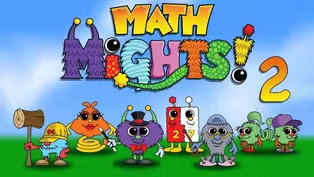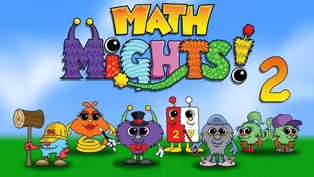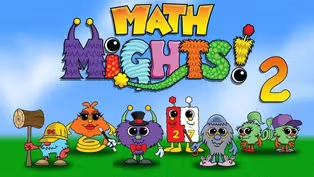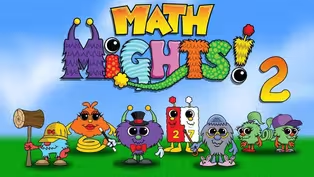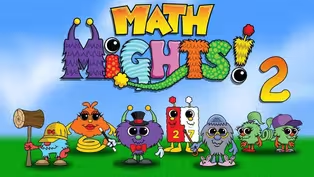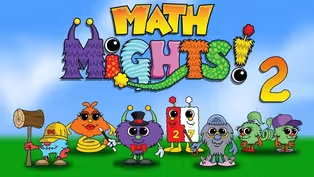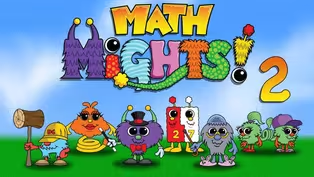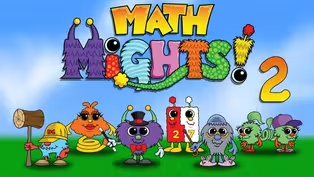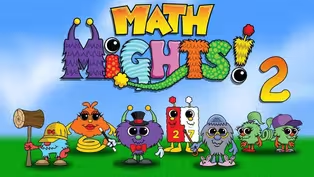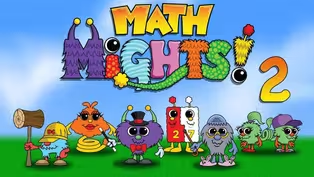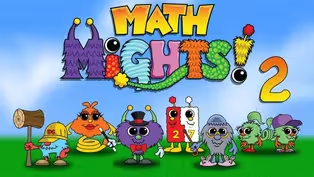Math Mights
Compose Shapes
Season 3 Episode 310 | 15m 59sVideo has Closed Captions
Join Mrs. McCartney for some fun with Professor Barble.
Join Mrs. McCartney for some fun with Professor Barble doing a tricky comparison word problem. Next we are going have some fun with pattern blocks composing different shapes. How many ways can you make a hexagon?
Problems playing video? | Closed Captioning Feedback
Problems playing video? | Closed Captioning Feedback
Math Mights is a local public television program presented by Detroit PBS
Math Mights
Compose Shapes
Season 3 Episode 310 | 15m 59sVideo has Closed Captions
Join Mrs. McCartney for some fun with Professor Barble doing a tricky comparison word problem. Next we are going have some fun with pattern blocks composing different shapes. How many ways can you make a hexagon?
Problems playing video? | Closed Captioning Feedback
How to Watch Math Mights
Math Mights is available to stream on pbs.org and the free PBS App, available on iPhone, Apple TV, Android TV, Android smartphones, Amazon Fire TV, Amazon Fire Tablet, Roku, Samsung Smart TV, and Vizio.
Providing Support for PBS.org
Learn Moreabout PBS online sponsorshipMore from This Collection
"Math Mights" lessons for 2nd Grade students.
Video has Closed Captions
Join Mrs. McCartney for some fun with Professor Barble. (15m 59s)
Video has Closed Captions
Join Mrs. McCartney for some fun with Professor Barble doing a tricky comparison. (15m 59s)
Video has Closed Captions
Join Mrs. McCartney for a word problem with Professor Barble that will make more sense. (15m 58s)
Video has Closed Captions
Join Mrs. McCartney for a comparison word problem with her friend Professor Barble. (15m 59s)
Compare 3-Digit Numbers Part 2
Video has Closed Captions
Join Mrs. McCartney to learn how to do a comparison word problem with Professor Barble! (15m 59s)
Comparing Numbers on a Number line
Video has Closed Captions
Join Mrs McCartney for a word problem with Professor Barble using Visula Models! (15m 59s)
Compare 3-Digit Numbers Part 1
Video has Closed Captions
Join Mrs. McCartney to see if we can figure out Professor Barble's comparison. (15m 59s)
Numbers represented in different ways
Video has Closed Captions
Representing numbers in different ways to show off your learning with place value. (15m 59s)
Video has Closed Captions
Put numbers together and taking them apart with expanded form. (15m 59s)
Video has Closed Captions
Join Mrs, McCartney for a Number Talk with her friend Springling! (15m 59s)
Video has Closed Captions
Join Mrs, McCartney for a Number Talk with her friend Springling! (16m)
Subtraction with 2-Digit Numbers Part 2
Video has Closed Captions
Join Mrs. McCartney for an addition number talk with D.C.! (16m)
Providing Support for PBS.org
Learn Moreabout PBS online sponsorship(smooth music) - [Students] Math Mights!
- Welcome back, second grade Math Mights.
My name is Mrs. McCartney.
I'm so excited that you've joined us for some math fun.
Today, we're going to do a word problem with my friend, Professor Barble, and then we're going to work on composing shapes.
We're going to warm up our brains first with doing a word problem with my friend, Professor Barble, as he conquers word problems, using visual models.
A visual model is something like a unit bar, a tape diagram, or even a model drawing.
The drawing is going to help us to figure out what the words are asking.
It's a reading comprehension strategy.
Let's have my friend, Professor Barble, join us.
He lives in Math Fil and really enjoys solving word problems.
He helps students to really slow down and stop from guessing if we add or just subtract when we really don't even know what the word problem is asking.
He oftentimes pushes on his thinking cap to have a starting line come out to help him to create the visual model.
Let's check out what our word problem is today.
Bennie has 36 crayons.
Anna has 12 fewer crayons than Bennie.
How many crayons does Anna have?
Our friend, Ty, says, "Maybe we should just add."
And our friend, Ricardo, says, "Wait, or should we subtract?"
Boys, we don't want to guess when it comes to word problems.
We want to know exactly what we're solving.
Let's go through this step-by-step process to help us to create a visual model so we understand what the story problem is really saying.
Step one starts off with reading the entire problem.
We're going to put a chunk in when we hear a new piece of information Bennie has 36 crayons, chunk.
That's a new piece of information.
Anna has 12 fewer crayons than Bennie.
Chunk.
How many crayons does Anna have?
Chunk.
Step two is to be able to put it into a sentence form where we leave a blank space for the answer.
It reads, Anna has hmm crayons.
Hmm means what the answer is going to be.
We're going to put that in after we solve it.
Step three involves some help from Professor Barble as we need that starting line to help us put in the who and/or the what.
Here you can see I have Bennie, and Anna is the who, and then the crayons.
This starting line just came out of Professor Barble's hat to help us to get started.
Step four is to put in our unit bars.
As you can see here, I've put in a unit bar for both Bennie and Anna.
They are both the same size because this bar represents Bennie's crayons and this bar represents Anna's crayons.
Step five is one of the hardest steps because we have to go back in the word problem.
We'll look at those parts that we chunked and we have to check them off once we put them into the word problem.
Let's read that first sentence.
It says, Bennie has 36 crayons.
I'm going to go to Bennie's bar and I'm going to put the number 36 because the word problem just told us that's how many crayons he has.
Let's go back in the word problem and check that chunk.
The next sentence says, Anna has 12 fewer crayons than Bennie.
So if this is Anna's bar, she does not have the same amount as Bennie does.
So I'm going to just kind of put a line here and put that she has 12 fewer, because we know that Bennie has more.
Let's go ahead and put that check in that chunk.
The last part says, how many crayons does Anna have?
We know that she has 12 less than Bennie.
So this box here would tell us how many crayons Anna has, which we don't know yet.
Let's go ahead and put that last check in.
step six is to correctly compute and solve the problem.
Ty said, "Slowing down really helped.
Thanks Professor Barble."
Our friend, Ricardo, said, "Oh, wow, I didn't understand the problem at first, but now I do."
Let's see, how are we going to solve this problem?
If these bars were the same exact size, we know that this was 36 but the problem told us it was 12 less than Bennie's.
So if we took the 36 and we subtracted the 12, it'll tell us how many crayons Anna has.
I'm going to go ahead and solve that problem here.
36 minus 12.
A problem like this, you might decide to use sprinkling or you might have other strategies.
I'm going to go ahead and use T pops for this one because it doesn't even involve a regroup.
So if I stack that problem this way, I know that six ones minus two ones equals four ones.
Three tens minus one 10 gives us two 10.
So we know that Anna had 24 crayons.
We can't forget our last step, which is step seven, to put our sentence form together with the correct answer.
It reads, Anna has 24 crayons.
Great job solving that word problem.
I know that my friend, Professor Barble, would be so happy with us slowing down to figure out how to solve that problem.
Let's check out our I can statement for today.
It says, "I can decompose and compose shapes."
Let's take a look at this interesting picture.
What do you notice and what do you wonder?
Well, I love working with pattern blocks.
Let's see what Ty and Ricardo think.
Ty said, "There's lots of shapes.
There are three kinds of quadrilaterals."
That was a really great notice.
Let's see if we can find those.
He said there are three kinds of quadrilaterals.
We know that a quadrilateral has four corners and four sides.
So the orange square would be one.
We can look at the rhombus here and see that it also has four sides and four corners.
I can also look at the trapezoid here and see that there are also four corners and four sides.
Great job, Ty.
That was really great to apply your thinking with what you already know about quadrilaterals.
Let's check out what Ricardo thinks.
Ricardo says, "There are two hexagons."
I can see the hexagons right here.
We know that it's a hexagon because it has six corners and six sides.
Let's see what the boys wondered.
Ty said, "How could I use shapes to make this image at different way?"
I bet he could take these shapes and move them around to create a new image.
Ricardo said, "How many shapes are in this picture?"
That's also a really great wonder.
It certainly is using a lot of different shapes.
What shapes were used to create the skateboard?
Okay, so I see a person here kind of standing and this here, they're kind of calling a skateboard.
It could also look like a bench, but they want to know which shapes are used to create this skateboard.
If I were to look at these, I see that there are squares, and then I also see the rhombuses.
You also could say that the skateboard is all made up of quadrilaterals.
Now that we know more about how to look at these types of shapes, maybe now we can compose shapes in different ways.
Ty created this beautiful butterfly out of pattern blocks.
How could we make it without using the hexagons?
Let's take a look at the picture.
I see one, two, three, four, five, six, hexagons.
If I said that you had to make Ty's shape but you could not use hexagons, what could you use as an alternate to take those shapes and compose them differently?
Let's check out Ricardo's idea.
He says that we could cover up the hexagons by using one triangle, one trapezoid, and one rhombus.
Let's check it out here.
I've created the butterfly design that Ty created and I'm going to see if we can compose a hexagon the way that our friend, Ricardo, suggested.
He wants us to put on here one trapezoid around this and then a triangle.
We could certainly cover up all of the hexagons by using those three shapes.
Is there another way that we can compose the hexagons differently than the way Ricardo did?
How many different ways can you compose a hexagon using other pattern block shapes?
Ricardo Ty work together to create a bunch of different ways that they could compose, which means to put together, the shape of the hexagon.
Take a look at all these different ways that they created the hexagon.
Let's take a closer look at our butterfly to see that all of them are displayed here.
We know that six triangles equal a hexagon, three rhombus create a hexagon, two trapezoids create a hexagon.
Here, we have a trapezoid and three triangles.
And this one has two rhombuses and two triangles.
That was a great job trying to put all those different shapes on top of them.
We put those shapes together, equally they create that hexagon, they're just composed in different ways.
Now take a look at these three images.
What is the same and what is different?
I notice something that's the same and something that's different.
All of them create a shape that's composed by other pieces.
The parts that's different is the shape on the left and the shape on the right are made or composed of the same shape.
So we have three squares that are creating the rectangle and then we use four triangles to create the other shape.
The one in the middle is composed of two different shapes.
What I want you to play close attention to is the shapes that are composed of the same pieces.
We're going to challenge you to see if you can compose three different shapes with two, three, or four of the same shape.
Name each shape and explain how you composed it.
Let's see what our friend, Ricardo, did.
He said, "I used three rhombuses and I composed a hat."
As you can see here, I have the three rhombuses that our friend, Ricardo, put together.
He composed it of three rhombuses and created another shape, which looks like a hat, or maybe you might think it looks like a crown.
Let's see what our friend, Ty, thought of.
He said, "I used four small squares to compose a large square."
Let's take a look at these shapes.
Which shapes are composed of equal-sized smaller shapes?
I wonder what you're thinking as you look at these pictures.
let's see what Ricardo thinks.
He said, "These shapes are composed of equal-size smaller shapes."
He is correct, he did a great job using that.
Let's see if we can put what Ricardo created with this sentence stem.
It says the blank is made up of blank, blank.
Let's take a look at the first shape that he said was made up of equal smaller shapes.
Here we have four squares that created a larger square.
So we can write in here, the square is made up of four squares.
Let's take a look at the second one.
Here we have three rhombuses and it created a hexagon.
So the hexagon is made up of three rhombuses Let's check out the last one.
Here we have one, two, three triangles, which made us a trapezoid.
So if we say, the trapezoid is made up of three triangles, that will be this sentence sum that will describe the shape that we created here.
That was really interesting to see how we use those equal-size shapes to create other shapes.
Do you think that we could do that using some other pattern blocks to create that and still fill in our sentence form?
I'm going to take some of my trapezoids and I'm going to see if I can create something by maybe putting out eight trapezoids to see if I can create another shape.
If I start to angle these, I want you to watch as I'm creating it to see if you can figure out what it is I'm trying to make.
I wonder if you've guessed it yet.
Let's check out to see.
I have one, two, three, four, five, six sides, and one, two, three, four, five, six corners.
I might just fill this in so you could see the whole shape created.
I think that this shape looks a whole lot like a larger hexagon.
So if we were to fill in the stem, we could say, the hexagon is made up of one, two, three, four, five, six, seven, eight trapezoids.
I bet you could create other shapes using the same equal-size smaller shape.
Now it's your turn to describe the shapes created, very similar to how we did today.
Second grade Math Mights, I've had so much fun hanging out with you and composing different shapes.
I sure hope to see you soon on a new Math Mights episode.
(smooth music) (playful music) - [Student] sis4teachers.org.
- [Student] Changing the way you think about math.
- [Narrator] This program is made possible with funding from the Michigan Department of Education, Governor's Education Emergency Funds, the State of Michigan, and by viewers like you.
(smooth music)


- Home and How To

Hit the road in a classic car for a tour through Great Britain with two antiques experts.












Support for PBS provided by:
Math Mights is a local public television program presented by Detroit PBS
